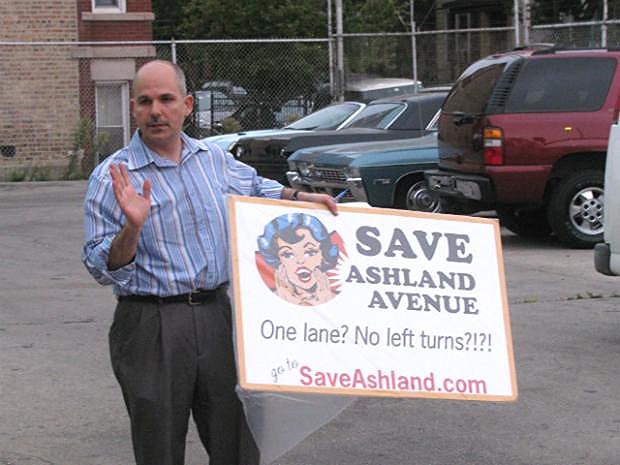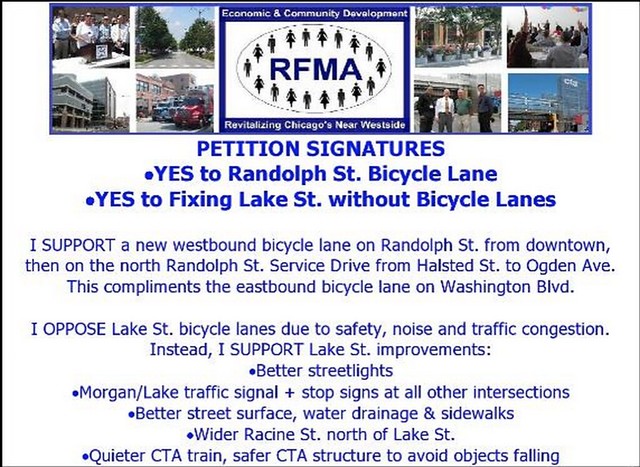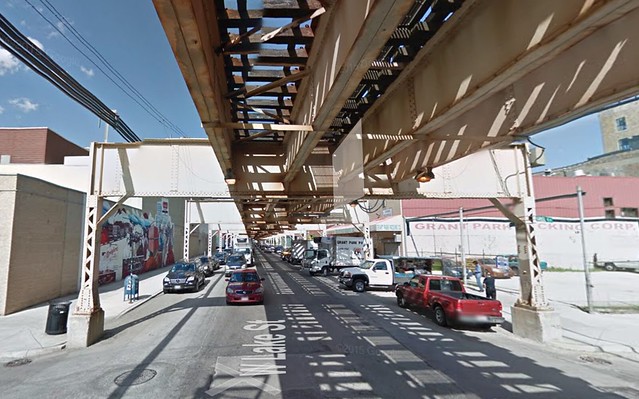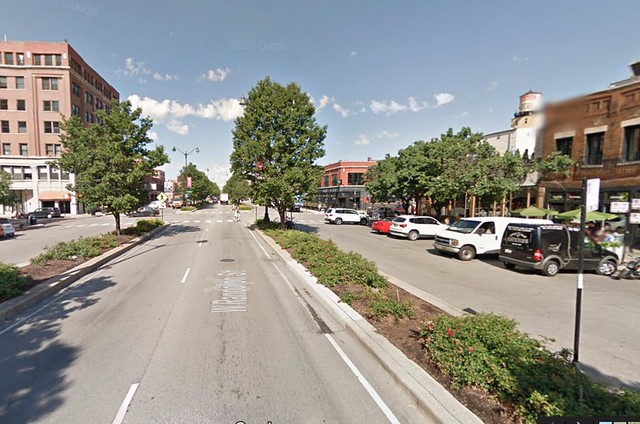
As the old saying goes, even a broken clock is right twice a day.
Streetsblog Chicago readers know Roger Romanelli as the guy who has led the charge against fast, reliable bus rapid transit on Ashland Avenue with his anti-BRT group the Ashland-Western Coallition. He also made headlines for asking Chicago Police Superintendant Garry McCarthy to force a historic church across the street from Romanelli’s home to stop its decades-long tradition of early-morning bell ringing. However, there’s some method to the madness of Romanelli’s latest NIMBY crusade.
As director of the Randolph/Fulton Market Association, which represents the interests of West Loop industrial businesses, Romanelli is currently opposing the Chicago Department of Transportation’s plan to install buffered bike lanes on Lake Street in the West Loop. Similar to how the North Branch Works industrial council futilely fought against installing buffered lanes on Elston Avenue north of North Avenue, he’s worried that more bikes on Lake would be an inconvenience to truck drivers.
In his campaign against the Ashland BRT project, which would involve converting mixed-traffic lanes to bus-only lanes, Romanelli cleverly proposed a watered-down alternative express bus proposal with some expensive bells and whistles. That way, he could disingenuously argue that he was advocating for better bus service, not just trying to kill the city’s plan.

Romanelli is shrewdly taking the same approach with the bikeway plan by arguing that Randolph Street, a street with less truck traffic than Lake, located a block south, would be a better location for the bike route. I’m confident that he would be glad to drop the idea of a bike lane on Randolph if CDOT shelved its plan for lanes on Lake between Halsted Street and Ashland Avenue. However, he happens to be correct: Randolph actually makes a lot more sense as a bike route.
Romanelli and the RFMA recently hosted a community meeting on the subject. He noted that Washington Street, a block south of Randoph, already has an eastbound buffered bike lane from Garfield Park to Halsted Street. CDOT is currently building an eastbound protected bike lane on Washington from Wacker Drive to Michigan Avenue as part of the Loop Link BRT project, and they’ll soon be adding a westbound PBL on Randolph from Michigan to Clinton Street as part of that project.
Therefore, it would be logical to continue the westbound route on Randolph in the West Loop. Meanwhile, since Lake becomes one-way eastbound east of Wacker, Washington works better as an eastbound route into the Loop.
In addition, while the Randolph in the West Loop is a lively, attractive street with plenty of destinations for cyclists in the form of restaurants, bars, and music venues, elevated tracks run the entire length of Lake Street, creating a gloomy, noisy environment. Moreover, the heavy truck traffic on Lake does pose a hazard to cyclists.
And, while CDOT has already built protected bike lanes on almost the entire length of the street from Damen Avenue to the suburb of Oak Park, we’ve heard from plenty of cyclists who dislike riding in those PBLs. In addition to the reasons above, the lanes are poorly maintained, filled with garbage and broken glass in the summer and snow in the winter.
CDOT has acknowledged that one of the main motivations for installing the PBLs on Lake, identified as a bike-priority Spoke Route in the city’s bike plan, was traffic calming. It’s also likely that it would have been more difficult politically to install PBLs on parallel residential or retail streets instead, since protected lanes generally require the removal of a few parking spaces to preserve sight lines.
Between Halsted and Ogden Avenue, Randolph consists of two central westbound lanes, plus westbound and eastbound service drives, separated from the main lanes by planted medians. Romanelli has proposed using one of the three westbound lanes for the bike lane.
Even though the idea is coming from a man whose main interest is reducing bike traffic on Lake, it’s an intriguing proposal. While CDOT’s standards allow two-way, four-lane streets to be converted into two lanes plus a turn lane if there are 20,000 average daily trips or fewer, this stretch of Randolph averages only 7,100 trips per day. Therefore, it’s likely that one of the main travel lanes on Randolph could be converted to a PBL with little impact on congestion.
Alternately, a buffered bike lane could be installed on the westbound service drive. This would require converting existing perpendicular parking to diagonal spaces and, ideally, requiring drivers to back into the spots, in order to calm traffic. The timing on the existing stoplights for the service drive would also need to be adjusted to be more bike-friendly.
Unfortunately, CDOT says that bike lanes on Randolph are a non-starter for the time being. They note that the Lake Street BBLs are being included as part of a street repaving project, which reduces costs, and that they’ve discussed the project many times with local alderman Walter Burnett, who has signed off on the plan.

CDOT also notes that bikes already account for up to ten percent of traffic on Lake during rush hours, a number that will likely increase as the West Loop’s development boom continues. Moreover, the Lake BBLs will require no reduction in travel lane width, and the paint-only buffered lanes won’t present an obstacle to truckers.
On the other hand, CDOT says, there would be a number of issues with installing a bike lane on Randolph at this time. It’s a state-jurisdiction roadway, so approval from the Illinois Department of Transportation would be required. IDOT previously blocked the city from installing PBLs on state roads, although the state recently piloted curb-protected lanes on Clybourn Avenue in River North.
To use a service drive on Randolph for the bike lane, loading zones, taxi stands, and valet stands would have to be heavily enforced to ensure no business is double parking, CDOT said. Several of the intersections on this stretch don’t have stoplights or stop signs which makes it difficult and confusing to cross north-south streets while riding in the service lanes, CDOT added.
However, the department said, putting bike lanes on Lake does not preclude installing them on Randolph in the future. Ideally, the lanes would be considered for Randolph as part of a major roadway reconstruction project, rather than a simple striping project, they said.
Therefore, Romanelli probably isn’t going to win his battle to get the planned Lake Street lanes relocated to Randolph. Personally, I’d rather ride on Randolph with no bike lanes than Lake Street with buffered lanes. However, since plenty of cyclists are already choosing to ride on Lake, there’s no downside to improving safety there right now by adding the buffered lanes. Hopefully, we can also add protected lanes on Randolph in the future and get the best of both worlds.





